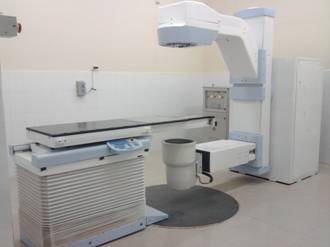DIGITAL
RADIOTHERAPY SIMULATOR

Radiation therapy is one of
the established modes of cancer treatment. Radiotherapy Simulator helps
to diagnose the physical extent of the tumor and its relation to the
surrounding tissues for proper selection of the size and orientation of
the radiotherapy beams. It is also useful to verify a treatment plan.
Radiotherapy simulator is an essential tool for improving the quality of
radiotherapy for the treatment of cancer patients.
Major sub-systems in the radiotherapy simulator are gantry,
collimator, x-ray tube, imaging unit, patient support/positioning system
(couch), and remote control console. It is similar to a external
beam radiotherapy machine except that diagnostic x-ray is used as source
of radiation. The variable focus to axis distance makes it suitable for
therapy simulation for a number of teletherapy machines. The collimated
x-ray beam passes through the patient (lying on the couch) from one side
and the attenuated beam is converted to digital image by an image
intensifier coupled with CCD camera system located on the other side.
The image intensifier support arm has motorized motions for remote and
interactive positioning of the image intensifier at the region of
interest. All the motions of the gantry, collimator, and the image
intensifier support arm can be controlled through these keypads (on the
couch) as well as from the remote control console.
The captured image can be processed / analyzed almost instantly to
extract detail information about the tumor location, its volume, and
closeness to critical structures. These images will be transferred into
the treatment planning computer system for formulating actual radiation
dose delivery plan. Immobilization device may be fabricated during this
procedure.
SALIENT FEATURES
- In the conventional form, a radiotherapy simulator is geometrically similar to isocentric external beam therapy machines to reproduce field arrangements for different teletherapy machines.
- All the motions in the main unit and the treatment table are motorized. This ensures faster patient positioning, and no unnecessary burden on the operator.
- It is a computer-controlled system. All motions of the main unit and the patient couch are monitored continuously. A database for the patient and simulation is maintained.
- Digital technology for fast and filmless operation. DICOM compatibility facilitates transfer of simulation plans to other equipments in the network.
- Advanced tools for image processing, annotations, contouring, displaying etc. to assist accurate planning.
- Dedicated collision avoidance system to reduce the risk of patient injury.
- User-friendly user-interface and operations- The operator interacts with the system using the mouse and keyboard located at the control console.
- Enhanced Security: In addition to physical key, selective access to operation, machine parameters, and patient/treatment data through password protection.
SPECIFICATIONS
|
: : |
800-1200 mm
1280 mm Motorized, isocentric design, ± 185 deg. Motorized, ± 100 deg. 450 mm x 450 mm (at FAD 1000mm) 400 mm x 400 mm (at FAD 1000mm) Motorized- four motions Power: 65KW KVp: 40-125(fluoro); 40-150(radiography) mA: 0.2-12.5(fluoro), 10-1000 (radiography)
Focal spot: 0.4 & 0.8; Target angle: 15deg |
INFRASTRUCTURE REQUIRED
The job involves high precision fabrication, assembly,
extensive QA testing as per national and international requirements. Machining viz. Turning, Milling, Drilling, Grinding,
Tapping etc. Gear Manufacture: Gear Generation, Grinding Casting Welding Hardening Electrical: Wiring, Soldering, etc. Inspection of parts and sub-assemblies. Lead handling/ melting/ pouring etc.
Machine Tools/ Equipments needed for Manufacture: Lathe, milling machine, drilling machine Precision tool room machines: lathe, milling machine
Inspection: height gauge, profile projector Universal grinding machine Crane: 2 T Capacity Space
Required Workshop of size 12m x 8m x 6m height for
manufacturing and fabrication of components Dust free room of size 10m x 8m x 6m height for
precision assembly X-ray shielded room of size 10m x 6m x 4m. Regular office space approx 100sq.m. Electricity Supply
Three phase power supply Manpower
Manpower consisting of 5 engineers (2-mechanical, 1-
electrical, 1-electronics, 1-computer) and 10 technicians for
fabrication, assembly and testing of the components, sub-assemblies, the
complete unit and its performance are required. Additionally, medical
physicist/radiation safety officer are required for ensuring conformity
to clinical requirement and radiation safety to the working personnel
respectively. Experience in Quality Assurance Requirements, Testing,
Certification and Regulatory Framework for this type of Medical
Electrical Equipments is essential
Manufacturing processes involved: